24.3: Fractional Lengths in Triangles and Prisms
( \newcommand{\kernel}{\mathrm{null}\,}\)
Lesson
Let's explore area and volume when fractions are involved.
Exercise 24.3.1: Area of Triangle
Find the area of Triangle A in square centimeters. Show your reasoning.
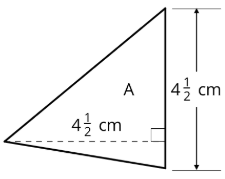
Exercise 24.3.2: Bases and Heights of Triangles
- The area of Triangle B is 8 square units. Find the length of b. Show your reasoning.
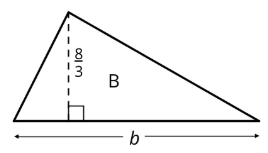
- The area of Triangle C is 545 square units. What is the length of h? Show your reasoning.
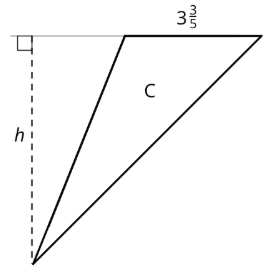
Exercise 24.3.3: Volumes of Cubes and Prisms
Use cubes or the applet to help you answer the following questions.
- Here is a drawing of a cube with edge lengths of 1 inch.
- How many cubes with edge lengths of 12 inch are needed to fill this cube?
- What is the volume, in cubic inches, of a cube with edge lengths of 12 inch? Explain or show your reasoning.
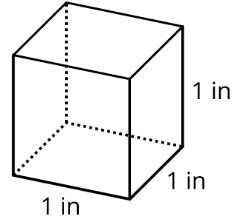
- Four cubes are piled in a single stack to make a prism. Each cube has an edge length of 22 inch. Sketch the prism, and find its volume in cubic inches.
- Use cubes with an edge length of 12 inch to build prisms with the lengths, widths, and heights shown in the table.
- For each prism, record in the table how many 12-inch cubes can be packed into the prism and the volume of the prism.
prism length (in) prism width (in) prism height (in) number of 12-inch cubes in prism volume of prism (in3) 12 12 12 1 1 12 2 1 12 2 2 1 4 2 32 5 4 2 5 4 212 Table 24.3.1 - Examine the values in the table. What do you notice about the relationship between the edge lengths of each prism and its volume?
- For each prism, record in the table how many 12-inch cubes can be packed into the prism and the volume of the prism.
- What is the volume of a rectangular prism that is 112 inches by 214 inches by 4 inches? Show your reasoning.
Are you ready for more?
A unit fraction has a 1 in the numerator.
- These are unit fractions: 13,1100,11.
- These are not unit fractions: 29,81,215.
- Find three unit fractions whose sum is 12. An example is: 18+18+14=12 How many examples like this can you find?
- Find a box whose surface area in square units equals its volume in cubic units. How many like this can you find?
Summary
If a rectangular prism has edge lengths of 2 units, 3 units, and 5 units, we can think of it as 2 layers of unit cubes, with each layer having (3⋅5) unit cubes in it. So the volume, in cubic units, is: 2⋅3⋅5
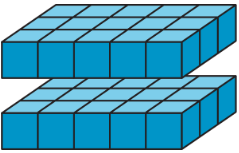
To find the volume of a rectangular prism with fractional edge lengths, we can think of it as being built of cubes that have a unit fraction for their edge length. For instance, if we build a prism that is 12-inch tall, 32-inch wide, and 4 inches long using cubes with a 12-inch edge length, we would have:
- A height of 1 cube, because 1⋅12=12.
- A width of 3 cubes, because 3⋅12=32.
- A length of 8 cubes, because 8⋅12=4.
The volume of the prism would be 1⋅3⋅8, or 24 cubic units. How do we find its volume in cubic inches? We know that each cube with a 12-inch edge length has a volume of 18 cubic inch, because 12⋅12⋅12=18. Since the prism is built using 24 of these cubes, its volume, in cubic inches, would then be 24⋅18, or 3 cubic inches.
The volume of the prism, in cubic inches, can also be found by multiplying the fractional edge lengths in inches: 12⋅32⋅4=3
Practice
Exercise 24.3.4
Clare is using little wooden cubes with edge length 12 inch to build a larger cube that has edge length 4 inches. How many little cubes does she need? Explain your reasoning.
Exercise 24.3.5
The triangle has an area of 778 cm2 and a base of 514 cm.
What is the length of h? Explain your reasoning.
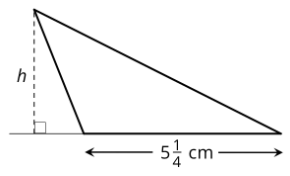
Exercise 24.3.6
- Which expression can be used to find how many cubes with edge length of 13 unit fit in a prism that is 5 units by 5 units by 8 units? Explain or show your reasoning.
- (5⋅13)⋅(5⋅13)⋅(8⋅13)
- 5⋅5⋅8
- (5⋅3)⋅(5⋅3)⋅(8⋅3)
- (5⋅5⋅8)⋅(13)
- Mai says that we can also find the answer by multiplying the edge lengths of the prism and then multiplying the result by 27. Do you agree with her? Explain your reasoning.
Exercise 24.3.7
A builder is building a fence with 614-inch-wide wooden boards, arranged side-by-side with no gaps or overlaps. How many boards are needed to build a fence that is 150 inches long? Show your reasoning.
(From Unit 4.4.1)
Exercise 24.3.8
Find the value of each expression. Show your reasoning and check your answer.
- 217÷27
- 1720÷14
(From Unit 4.4.1)
Exercise 24.3.9
Consider the problem: A bucket contains 1123 gallons of water and is 56 full. How many gallons of water would be in a full bucket?
Write a multiplication and a division equation to represent the situation. Then, find the answer and show your reasoning.
(From Unit 4.3.2)
Exercise 24.3.10
There are 80 kids in a gym. 75% are wearing socks. How many are not wearing socks? If you get stuck, consider using a tape diagram.
(From Unit 3.4.3)
Exercise 24.3.11
- Lin wants to save $75 for a trip to the city. If she has saved $37.50 so far, what percentage of her goal has she saved? What percentage remains?
- Noah wants to save $60 so that he can purchase a concert ticket. If he has saved $45 so far, what percentage of his goal has he saved? What percentage remains?
(From Unit 3.4.2)

